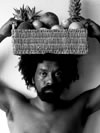Performance/Talk, HAU 3: April 14, 7 pm – 10 pm
Performance: “Ass de luxe with naked body”
with Fafá Carvalho, Gui Alcântara/ concept, director: Luiz de Abreu
Our understanding of identity and individuality, as well as our feeling of belonging to a distinct ethnic, racial, linguistic, religious or other community is changing. This performance examines the change in the concepts of identity that structure us as individuals revealing characteristics of mind and body. Simultaneously, these registers recount both private as well as collective takes that even today gives some communities back a feeling of belonging that was previously negated.
Talk: Dance of color: How Present are Blacks in Brazilian Dance? How Do They Influence It?
Presentation: Wagner Carvalho
The African contribution to Brazilian culture is increasingly being acknowledged. Based thereon concepts of identity in their relation to dance and music will be discussed. The reality of the black community in Germany will act as a counterpoint in the discussion.
 The
Dance of the Baina – Women of Bahia:
The
Dance of the Baina – Women of Bahia:
Fafá Carvalho (Salvador) – actress, dancer and art
teacher. Student of Scenic Arts at the UFBA. She currently teaches
Contemporary Afro-Dance in the Fundação Cidade Mãe
for children and teenagers from poor backgrounds who are living
in Salvador in difficult social surroundings.In a globalized world the discussion centers on the fragmentation of the individual and society’s reaction to this development, which is continually subject to transformation processes. In today’s world distances have become shorter. This results in what Stuart Hall calls the “phenomenon of dislocation” in the sense that old concepts of identity have become obsolete. The individual has lost its point of reference in the social world. In the case of Afro-Brazilians, we try to hold onto the remnants of our cultural heritage: dance, music, song and cuisine – also as an affirmation of identity. These aspects express our magnitude as well as our simplicity. From this perspective, we will discuss the various possibilities of identification that form the individual as well as the characteristics of his mind and body on the basis of personal history.
 Samba, Ownership
of the Body: An Ideology of Resistance:
Samba, Ownership
of the Body: An Ideology of Resistance:
Gui Alcântara (Salvador) – Specialization in clinical
and educational movement coordination. Sports diploma from the
UCSal, Contra-Mestre in Capoeira, trained by the internationally
renowned Grupo Tópazio, drummer and percussionist. Works
with children and teenagers living in the streets. He is currently
the coordinator of the Capoeira Nucleus and the Axé Project’s
Berimbau Orchestra.In samba, the dancing body articulates an ideology of resistance. With its wide range of styles, Brazilian music offers the people a possibility of political expression. The protection of the Brazilian cultural identity, its customs and traditions are increasingly the focus of discussion.
 »Black
Body«, (In)Visible Body:
»Black
Body«, (In)Visible Body:
Luiz de Abreu (São Paulo-Salvador) – Dancer and choreographer.
Originally from Araguarí in Minas Gerais, he had his first
encounter with dance through the Umbanda cult. He studied dance
in Uberlândia and in Belo Horizonte and worked in numerous
dance companies. His solo career began in the mid 1990’s
in São Paulo. Since 2004, he has dedicated his research
to the study of the ‘black body’. His solo “Samba
of the Crazy Nigger” was the opening piece of move berlim
2005.The (in)visibility of the black body in contemporary Brazilian dance in the focal point of this debate. Luiz de Abreu looks at two main questions: What will become of contemporary dance? How can the marginal presence of blacks be translated into the aesthetic and ideological discourse of contemporary dance? Dance, here understood as an ideological construction that regards the back body as an object and not as a subject within the established parameters, is to be reassessed. These themes are also present in Luiz de Abreu’s stage work, such as “Samba of the Crazy Nigger”, “Human Demoralization Machine”, “Black Fashion”, “Travesti” and others.
 Black
Poetry for the Squalor and the Beauty of the Cities:
Black
Poetry for the Squalor and the Beauty of the Cities:
Carmen Luz (Rio de Janeiro) – Postgraduate in the field of
documentary film at Foundation Getúlio Vargas and in Theater
Studies at the UFRJ. Brazilian Literature at the UFRJ. Choreographer,
dancer, professional actress, director and professor for Theater
Education, Rio de Janeiro. Founder and artistic director of the
Cia.Étnica de Dança e Teatro and coordinator of the
Projeto Encantar. She is also a consultant for the Centro Coreográfico
of the City of Rio de Janeiro.On the basis of a long-term study of people living in the streets in Brazilian cities, we will discuss, with regard to the ATITUDE theory, concepts of hate and solidarity, the reinvention of the everyday by the poor and a selection of performance and intervention formats by the black body in urban space. In addition, Carmen Luz will show on DVD, images of performances and choreographies shown in Rio de Janeiro in the Museu de Arte Contemporânea and at the Arpoador Beach.
 Being
Black in Brazil and Germany:
Being
Black in Brazil and Germany:
Ekpenyong Ani (Berlin) – Certified translator, editor and
executive director of the Orlanda Publishing House in Berlin. Since
1993 active in ADEFRA – Black Women in Germany as well as
in the broader black community. Publications in the journal “The
African Courier“ as well as in “AufBrüche. Kulturelle
Produktionen von Migrantinnen, Schwarzen und jüdischen Frauen
in Deutschland“ (ed. Gelbin/Konuk/Piesche, 1999) and in
the Heinrich Böll Foundation’s online dossier on migration:
Black Community in Germany.It is generally know that Brazil’s history is closely connected to that of the African continent, to colonialism and slavery. But what is still relatively unknown is that there are also parallels in Europe. Meanwhile there is increasing talk of a black Diaspora; what does this mean in the context of Brazil-Germany? What do black activists and artists in Germany and Brazil have in common? Can one speak of a platform for black artists in Germany and if yes, how can its members act outside the confines of exotization and the exploitation of the black body? These and other questions are to be addressed in the discussion.

